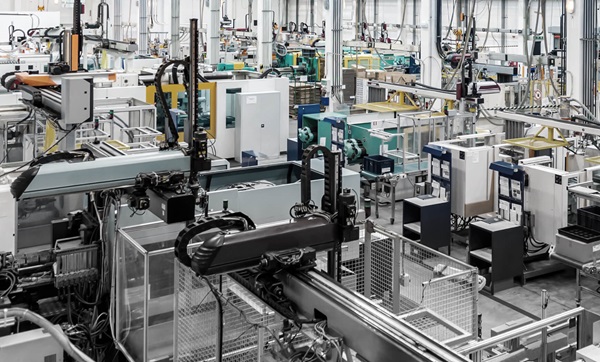The rise of available data, connectivity, analytics, human-machine interaction, and improvements in robotics characterizes the fourth industrial revolution. The wave of digital changes that started in the mid-2010s shows no signs of slowing, and manufacturers must embrace all that Industry 4.0 has to offer to remain competitive.
Information technology (IT) is impacting processes in a fundamental way as the lines between IT and operational technology (OT) become blurred. OT is represented by the hardware on the factory floor – the devices doing the actual work. In many cases these pieces of equipment are already automated, but frequently in a piecemeal and insular fashion, so that just a few machines affecting a certain part of the process are integrated and communicating. With Industry 4.0, all machinery, control systems, and IT systems will be connected horizontally and vertically throughout an organization, cooperating to optimize processes and productivity.
Connected production floors allow companies to monitor equipment and machinery, tracking statuses at any given moment. Leveraging the data available from their machines means that manufacturers can improve performance, help prevent asset failure, and make decisions based on facts which could otherwise be left to guesswork.
Embracing the revolution
While perceived barriers of full Industry 4.0 implementation include cost, employee knowledge, and time, Videojet is helping manufacturers take advantage of the connectivity of their printing, labeling, and laser marking systems with a “born digital” ideology. These Videojet printers produce two sets of data: operational data that relates to the printer’s own requirements and process data that describes what is happening on the production line.
Wi-Fi allows born digital Videojet printers and lasers to connect easily to a manufacturer’s internal networks with no need for cables or hardwiring. Embedded cellular connections, where available, communicate between the Videojet cloud and the printer and eliminate the need to use the manufacturer’s own IT infrastructure. Cellular-enabled Videojet printers are fitted with e-SIM cards to ensure the printer selects the carrier with the best cell signal available in a region.
At one manufacturing site, a Videojet customer embraced the ‘born digital’ philosophy wholeheartedly and networked their fleet of Videojet printers, resulting in the elimination of date coding errors at the site. Since all product coding data is now centrally controlled, operators can simply scan a work order and the system pushes the relevant date to each printer. The site is now used as a beacon of ‘what good looks like’ for new suppliers to the business.

Printer-level data
With the latest Videojet solutions, factory managers can track production speeds, error rates, and equipment performance with unparalleled precision. For instance, the advanced Videojet 1880 + continuous inkjet (CIJ) printer features 53 sensors that monitor processes in real time. The sensors track the printer’s performance and follow the sequence of events to detect potential faults.
With several components being monitored, troubleshooting is swift and accurate with the Videojet 1880 +. For example, if the pump speed has slowed and is recording a higher-than-usual operating temperature, a blockage in the cooling air inflow may be the cause. By reading the data from multiple sensors, the machine can self-diagnose and suggest the steps needed to fix the problem. The goal is to reduce the main causes of unplanned printer downtime.
Of course, uptime is critical to the profitability of any business. While emergency repairs are costly, the greater damage to the bottom line may be caused by the unexpected time an asset is down and not contributing to production. Prolonged stoppages can have a longer-term impact on customer relations if they lead to delayed or unfulfilled orders. By taking advantage of a printer’s preventive maintenance features, emergency repairs can be reduced or avoided.
Stay ahead with real-time updates on the latest news:
Line and site-level data
Employing printers and lasers as proxies, users can access data and reports that go beyond a printer’s or laser’s operational data, diagnostics, and machine controls. Visibility to production data across multiple lines is possible, as well as the performance of individual lines for certain days, shifts, and production runs. Projections for both the current and best run rates help determine if a production is on-target, while OEE can be tracked on an hourly basis throughout a shift. Users can extract key data directly into their own systems, facilitating the building of dashboards and integration into existing maintenance systems.
Driving future improvements
With customers’ permission, Videojet is collecting anonymous analytics data across its population of printers to draw conclusions from varying running conditions. This information is used to both improve the reliability of printer hardware and provide performance data that can help prevent unplanned downtime with the use of analytics and artificial intelligence (AI).
Connectivity in coding and marking machines is not just about enhanced data gathering and decision-making, it’s a catalyst for a fundamental shift in how manufacturers interact with their production processes. As the manufacturing landscape evolves, the future promises not just faster production lines but smarter and more sustainable manufacturing processes.
